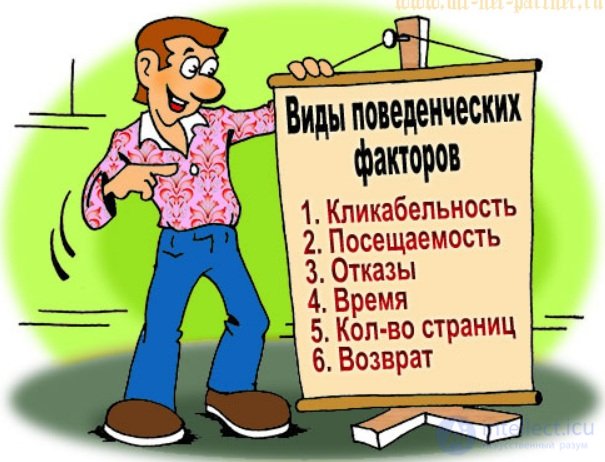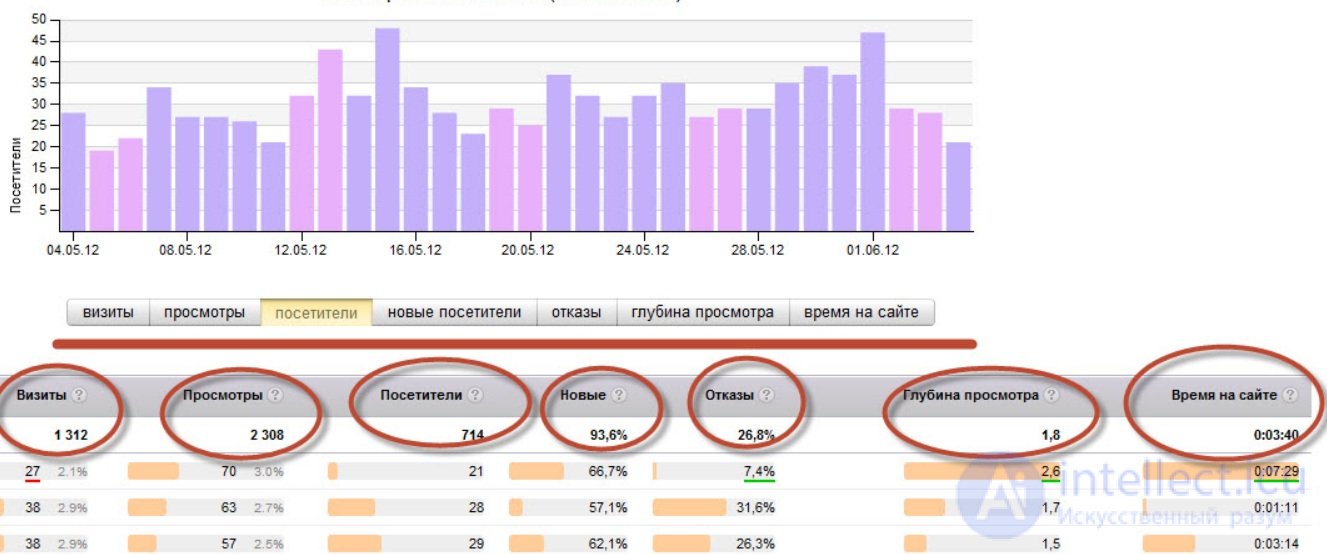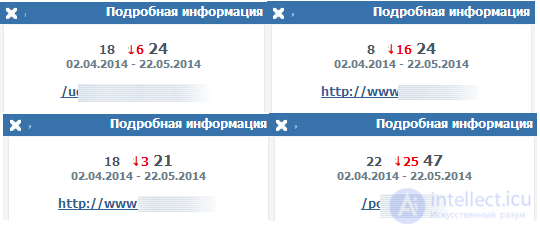Lecture
A couple of years ago it was not at all difficult to influence search results, having mastered a couple of cunning manipulations with the site. Now the search has become more intelligent and prioritizes from quantity to quality of site content. Website promotion at the present stage is not a mechanical work. It should be aimed at the full development of the resource. And we do not discover America when we say again that a good site should be convenient, interesting and useful to users. And now even the search engines are able to adequately match these parameters, focusing on the behavior of users on the site.
How to be here for us, for whom SEO is not just an interest, but a profession? In short - to make the NLL and not really worry. If not quite briefly - then work and read further this article.
Behavioral factors are actions that visitors perform on the site. Logging in to the site, time spent, the number of pages viewed and clicks on links, cases of re-returning to the site - all these points are attributed to behavioral factors.
In this article we tried to briefly describe the behavioral factors of Yandex and Google search engines, drawing your attention to some features of behavioral ranking when promoting a website, knowledge of which helps to better understand the essence of this technology.
Behavioral factors exist and they are already promoting sites in the tops of Yandex and Google. This is indeed the case now, it is completely inappropriate to cast doubt on this ranking parameter.

Behavioral factors - a set of parameters that work on the principle of an unbroken chain. Behavioral factors take into account more than 10 different parameters. Their work is based on complex maps of visitor activity on the site, which are individual for different topics. Activity maps (or graphs of compliance of parameters) are selected by assessors for various topics and are processed by Yandex robots. For each topic, unique ratios are defined for all parameters characterizing the quality of the site. When trying to cheat behavioral factors, it is simply impossible to track all the parameters (since they are not unknown), the cheat is visible instantly when the activity graphs sharply go beyond the standardized parameters.
The Yandex search system in other ways, like Google, through its statistics, gives us the opportunity to analyze and improve the primary parameters of user behavior. We have identified the following factors, a noticeable increase or decrease in which leads to a promotion in the top in the search results of your site:
1. Bounce rate The percentage of visitors who left after viewing the primary page. This parameter should be reduced.

2. Time on the site, held by the visitor in one session. This factor should be increased. The connection is clear, a long time guarantor of interesting information on the site.
3. Depth of view. An important factor for SOM. You can increase the depth due to well-thought linking and, of course, interesting content. It works only when a visitor moves to another page and stays there for a long time.
4. Return to re-search. If the visitor returns to the search engine after viewing your promoted site. This parameter cannot be controlled explicitly. This behavior can only be improved by increasing the relevance of the pages being promoted.
5. The periodicity of visits and return to the site. For example, through bookmarks or a visitor remembered the address and entered it in the browser. For a search engine, this is a signal that the site is liked.
6. Clikablity snippet in the issue. If you click on your snippet in the top of the search engine, then the visitor spends enough time, then the snippet is relevant to the request. The promoted query will visibly think the site in search.

For each subject of the site there is its own optimal ratio of user behavior. The ideal scheme simply does not exist. Want to get to the top? Make an analysis of the TOP results of search engines for the desired keyword and try to follow the successful examples already on your site.
It makes no sense to specifically cheat behavioral factors, but they can certainly be improved. Improving them is not so difficult, in addition, you will definitely increase the conversion. Here is a list of the best ways to improve the influence of behavioral factors in website promotion:
And at the end of a little seo-meditation ...
Aspiration.
Objectivity.
Development.
Interest.
Benefit.
SEO.
Today I would like to tell you about a very intriguing thing, like behavioral factors. Or rather, about their artificial improvement. And more precisely, about the shortcomings of services-cheaters that do it.
Why am I writing this? The fact is that I am the owner of two commercial sites and, of course, I am interested in finding them as high as possible in search results. And at some point, after reading various articles, he decided to experiment. At once I will make a reservation that the result was a bit sad and I hope that this article will serve as a warning.
Given:
For greater “purity,” I did not make any changes on the site, except for posting articles once every one or two weeks. I note that I am not going to compare the positions before and after, but the traffic, since for me personally this is a more important metric.
It did not take long to think about this moment - I decided to use the most actively advertised and new service at that moment. I will not give a link to it, but I will only say that it has an interesting name and logo. :)
After sitting in the forums and studying articles from several sources I was pleased with the following decision:
That is, approximately I added 15% of the current monthly traffic. I think that it will be clear to the majority that it is somewhat doubtful to wind such a number of transitions on 1-3 requests, then I selected 80-90 LF and MF requests for each site.
During the project setup in the service, I was immediately jarred by the lack of installation of the viewing depth and time on the site.
I believe that each site of a particular subject has its own depth and time of viewing the site. If for my sites the average depth is 4 pages, and the time is 4-5 minutes, then the shaft of visits with a depth of 2-3 pages and a time of 2-3 minutes somehow gets out of the general statistics. In the end, it happened.
Yandex.Metrica has very remarkable and informative sections “Gender and age” and “By countries of the world”.
So, if in the subsection “By Countries of the World” Russia, the Center (and a little North-West) always prevailed, then after a month of progress I saw the Urals, the South, Siberia, the Volga region. Also, the CIS “actively joined”: Ukraine, Belarus, Kazakhstan and many other things.
In the subsection “Gender and age” the picture is typical for my sites: the main audience is men over 25 years old. After a month of promotion, a female audience began to grow, as well as an audience under 18 years of age.
Well, is it not a failure case? Naturally, the support of the service actively persuaded me in this, after I sent them a ticket with comments. The essence of the belief was one thing - " We firmly believe that the Yandex Yandex does not take into account the data about which you wrote ." Point.
We should also highlight how tasks are performed:
It is very strange when a user from Poltava changes the region to Moscow and searches for concrete blocks, when yesterday he was looking for GDZ for the 8th grade. Then the user clicks on two random sites. Yeah. Most often these are sites from the TOP-5 or TOP-10. After reviewing the sites, the user abruptly goes to the site from 29 places and then finishes the search. Yes-ah, very natural behavior.

“What is this?” You ask. And this is the scale of user activity from the web browser. It displays typical user behavior from the cheat service on my site. According to my calculations, 7 out of 10 users behaved this way. For those who do not know what these colors mean on the activity scale: 
That is, the user went to my site, “jerked” for 20 seconds, then switched to another window and did something for 2 minutes. Then he returned, clicked somewhere and closed the page. It is clear that most likely the “worker” performs several tasks at the same time, which causes him to switch to another window.
And in the appendix to everything: in WebVisor, you can filter out visits of a specific visitor, which helped me find another flaw - one user can complete the task several times a week.
After a difficult 4 months, I decided to finish the epic with this experiment. I will not bother with a story about other problems, such as incorrect removal of positions, an incomprehensible algorithm for performing tasks and writing off funds, numerous minor bugs in the interface (which they promise to fix, but this does not happen) and much more.
It turned out that in 4 months I spent about 40 thousand rubles, a lot of time and nerve cells . At the beginning of May, a week after stopping the promotion, I recorded the following traffic:
At the beginning of the post, I promised not to compare the positions, but, as a digestif, it is worth doing: 
If you decide to use behavioral cheating, then remember the drawbacks of “cheaters” :
For myself, I decided that in the future I will not use dubious gray methods. And I do not advise you.
Thanks for attention!
Comments
To leave a comment
seo, smo, monetization, basics of internet marketing
Terms: seo, smo, monetization, basics of internet marketing